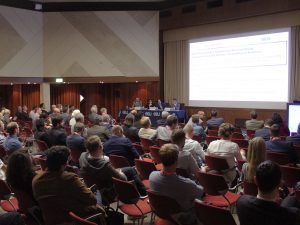Even the most experienced robotic surgeons are constantly refining their technique, which means that every time they operate at an ERUS meeting, the audience picks up on little adjustments. Prof. Declan Murphy, who moderated the first of ERUS19’s six live surgery sessions made this point about Dr. Vip Patel and his nerve-sparing robot-assisted radical prostatectomy in Lisbon.
“Dr. Patel has performed over 13,000 cases, and you can tell that his technique has evolved over the years. Just little adjustments in how he manages the apex of the prostate, to the betterment of the patient. These subtle changes get our attention and really makes it worthwhile to keep coming back to ERUS year on year.”
The first day of the regular ERUS19 programme attracted over 600 delegates for three live surgery sessions, a session on surgical training, a ‘controversies’ debate session and a Joint Symposium with the European Association of Nuclear Medicine.
Live surgery
“The annual ERUS meeting is very famous for the quality of its live surgery,” said Prof. Murphy. “This opening day has been very spectacular, featuring all the things that we expect from ERUS. The world’s best-known and most highly-regarded surgeons performing complex surgery in kidney, prostate and bladder.”
About the level of the procedures on display: “We are at a point that the audience is experienced enough for ERUS to routinely demonstrate advanced evolutions of technique. That’s why there’s over 600 delegates every year. In the coffee breaks, everyone is chatting about little details that they noticed during the live surgery. And of course, sometimes it’s not perfect. It is reassuring for less experienced surgeons to see that things can get tricky during a case. In pre-recorded cases, the procedures often look perfect. In a live setting, you see more of the struggle and the improvisation that takes place, and this makes it educationally valuable.”
One case in which some improvisation was definitely necessary was Prof. Wiklund’s cystectomy with pelvic lymph node dissection and ileal conduit. Upon inspection, Prof. Wiklund discovered growths around the bladder that suggested that the cancer was perhaps more extensive than pre-operative scans and biopsies indicated.
“That’s the nature of cancer surgery,” said Murphy. “Prof. Wiklund adjusted his plans, and took some frozen sections to optimize the outcome for the patient. He was able to complete the surgery as planned. It wasn’t clear in advance if it was safe to create a neobladder, but thankfully this was the case and the patient will wake up with this favoured outcome.”
Every ERUS meeting begins with an ‘audit’ of the previous year’s live surgery cases, in accordance with the EAU’s Live Surgery Guidelines. This year, Dr. Jochen Walz took to the stage to detail each patient from ERUS18 in his home institution in Marseille.
“Dr. Walz’s report was detailed and complete. As one of the surgeons last year, I was happy to see that my patient had no complications. There were some complications to report, all acceptable. I would say that the rate of 41% was more than compatible with what we would expect from very good surgeons.”
A theme of NeuroSAFE
NeuroSAFE is a relatively new technique that uses real-time frozen section analysis to maximize nerve preservation with effective cancer control. The third surgery of the first session was a robot-assisted radical prostatectomy with NeuroSAFE performed by Prof. Markus Graefen.
Murphy: “This was a nice exposition from one of the pioneers of the procedure. In the next session, we then a robust academic debate about its usefulness between pathologist Prof. Eva Compérat (against) and Dr. Bernardo Rocco (for). Based on audience poll, I think most delegates not yet convinced of the use of fresh frozen sections outside of specialist centres.”
Prof. Murphy was personally enthusiastic about the potential. “A technique has been established and prospective randomized trials are currently being conducted. As Dr. Rocco conceded, there are still some unanswered questions aside from the additional time, cost and resources associated with the real-time section analysis.”





